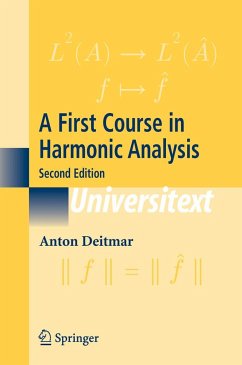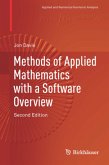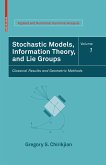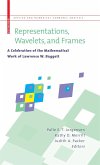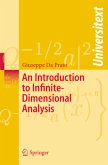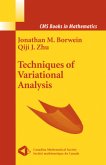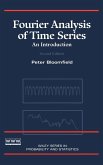Affordable softcover second edition of bestselling title (over 1000 copies sold of previous edition) A primer in harmonic analysis on the undergraduate level Gives a lean and streamlined introduction to the central concepts of this beautiful and utile theory. Entirely based on the Riemann integral and metric spaces instead of the more demanding Lebesgue integral and abstract topology. Almost all proofs are given in full and all central concepts are presented clearly. Provides an introduction to Fourier analysis, leading up to the Poisson Summation Formula. Make the reader aware of the fact that both principal incarnations of Fourier theory, the Fourier series and the Fourier transform, are special cases of a more general theory arising in the context of locally compact abelian groups. Introduces the reader to the techniques used in harmonic analysis of noncommutative groups. These techniques are explained in the context of matrix groups as a principal example.
The second part of the book concludes with Plancherel's theorem in Chapter 8. This theorem is a generalization of the completeness of the Fourier series, as well as of Plancherel's theorem for the real line. The third part of the book is intended to provide the reader with a ?rst impression of the world of non-commutative harmonic analysis. Chapter 9 introduces methods that are used in the analysis of matrix groups, such as the theory of the exponential series and Lie algebras. These methods are then applied in Chapter 10 to arrive at a clas- ?cation of the representations of the group SU(2). In Chapter 11 we give the Peter-Weyl theorem, which generalizes the completeness of the Fourier series in the context of compact non-commutative groups and gives a decomposition of the regular representation as a direct sum of irreducibles. The theory of non-compact non-commutative groups is represented by the example of the Heisenberg group in Chapter 12. The regular representation in general decomposes as a direct integral rather than a direct sum. For the Heisenberg group this decomposition is given explicitly. Acknowledgements: I thank Robert Burckel and Alexander Schmidt for their most useful comments on this book. I also thank Moshe Adrian, Mark Pavey, Jose Carlos Santos, and Masamichi Takesaki for pointing out errors in the ?rst edition. Exeter, June 2004 Anton Deitmar LEITFADEN vii Leitfaden 1 2 3 5 4 6
Hinweis: Dieser Artikel kann nur an eine deutsche Lieferadresse ausgeliefert werden.
The second part of the book concludes with Plancherel's theorem in Chapter 8. This theorem is a generalization of the completeness of the Fourier series, as well as of Plancherel's theorem for the real line. The third part of the book is intended to provide the reader with a ?rst impression of the world of non-commutative harmonic analysis. Chapter 9 introduces methods that are used in the analysis of matrix groups, such as the theory of the exponential series and Lie algebras. These methods are then applied in Chapter 10 to arrive at a clas- ?cation of the representations of the group SU(2). In Chapter 11 we give the Peter-Weyl theorem, which generalizes the completeness of the Fourier series in the context of compact non-commutative groups and gives a decomposition of the regular representation as a direct sum of irreducibles. The theory of non-compact non-commutative groups is represented by the example of the Heisenberg group in Chapter 12. The regular representation in general decomposes as a direct integral rather than a direct sum. For the Heisenberg group this decomposition is given explicitly. Acknowledgements: I thank Robert Burckel and Alexander Schmidt for their most useful comments on this book. I also thank Moshe Adrian, Mark Pavey, Jose Carlos Santos, and Masamichi Takesaki for pointing out errors in the ?rst edition. Exeter, June 2004 Anton Deitmar LEITFADEN vii Leitfaden 1 2 3 5 4 6
Hinweis: Dieser Artikel kann nur an eine deutsche Lieferadresse ausgeliefert werden.
From the reviews of the first edition:
"This lovely book is intended as a primer in harmonic analysis at the undergraduate level. All the central concepts of harmonic analysis are introduced using Riemann integral and metric spaces only. The exercises at the end of each chapter are interesting and challenging; no solutions are given. ..." -- Sanjiv Kumar Gupta for MathSciNet
"... In this well-written textbook the central concepts of Harmonic Analysis are explained in an enjoyable way, while using very little technical background. Quite surprisingly this approach works. It is not an exaggeration that each undergraduate student interested in and each professor teaching Harmonic Analysis will benefit from the streamlined and direct approach of this book." -- Ferenc Móricz for Acta Scientiarum Mathematicarum
From the reviews of the second edition:
"This is the second edition of a beautiful introduction to harmonic analysis accessible to undergraduates. ... The first part deals with classical Fourier analysis, the second provides the extension to locally compact abelian groups, and the third part is concerned with noncommutative groups." (G. Teschl, Internationale Mathematische Nachrichten, Issue 202, 2006)
"This lovely book is intended as a primer in harmonic analysis at the undergraduate level. All the central concepts of harmonic analysis are introduced using Riemann integral and metric spaces only. The exercises at the end of each chapter are interesting and challenging; no solutions are given. ..." -- Sanjiv Kumar Gupta for MathSciNet
"... In this well-written textbook the central concepts of Harmonic Analysis are explained in an enjoyable way, while using very little technical background. Quite surprisingly this approach works. It is not an exaggeration that each undergraduate student interested in and each professor teaching Harmonic Analysis will benefit from the streamlined and direct approach of this book." -- Ferenc Móricz for Acta Scientiarum Mathematicarum
From the reviews of the second edition:
"This is the second edition of a beautiful introduction to harmonic analysis accessible to undergraduates. ... The first part deals with classical Fourier analysis, the second provides the extension to locally compact abelian groups, and the third part is concerned with noncommutative groups." (G. Teschl, Internationale Mathematische Nachrichten, Issue 202, 2006)

